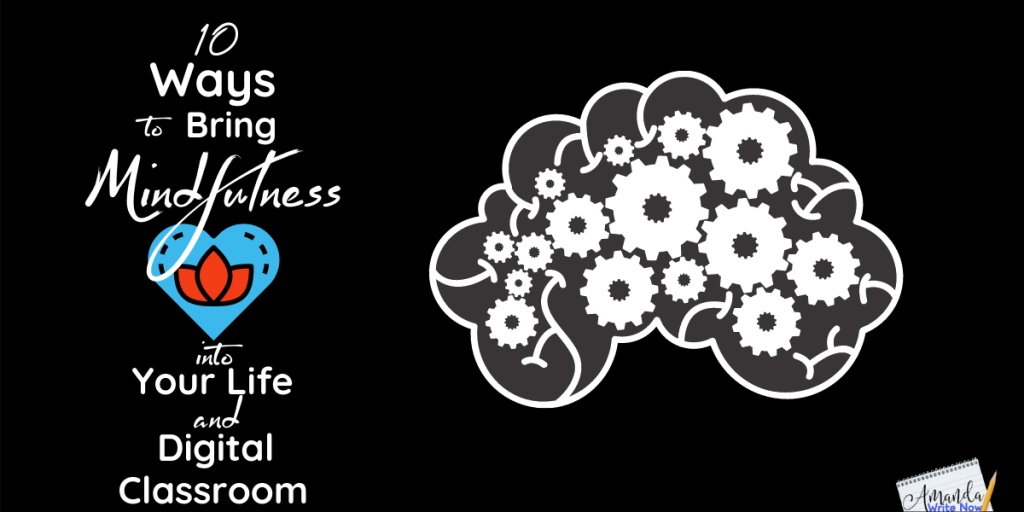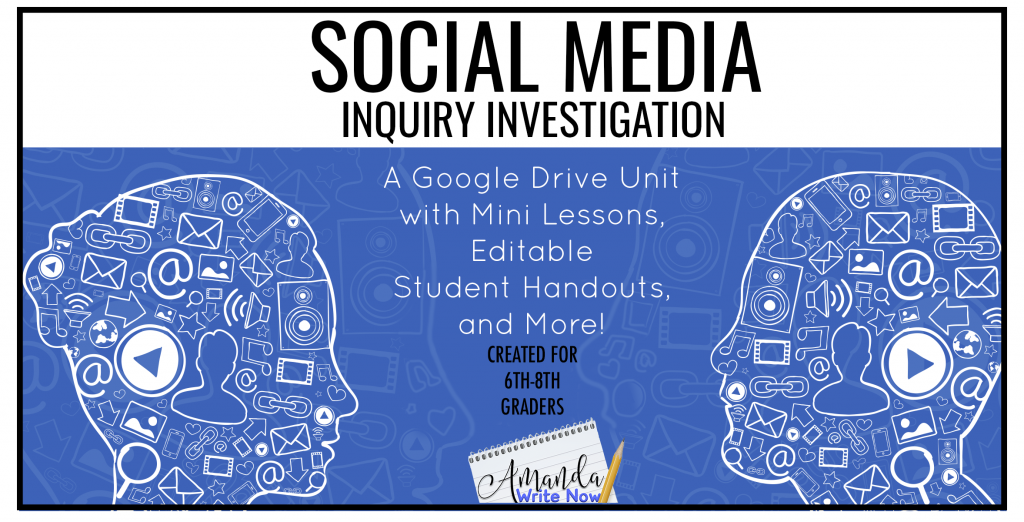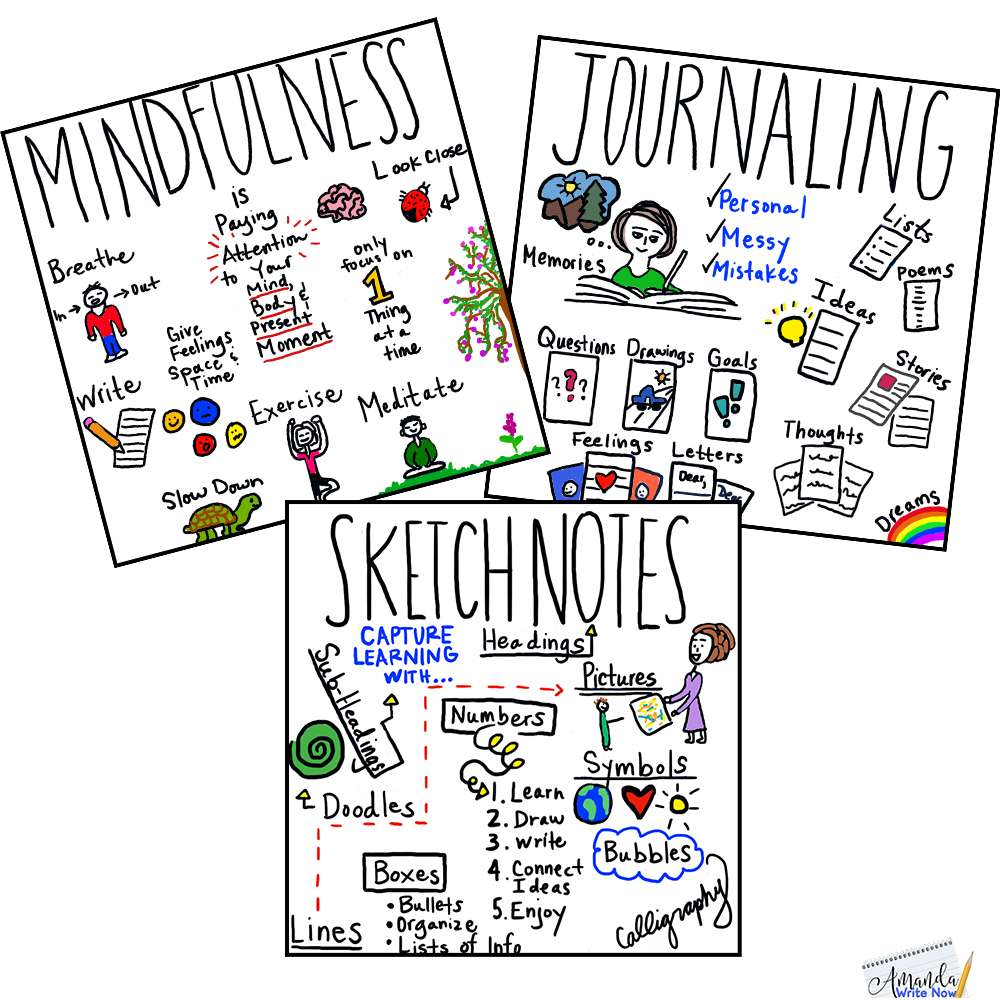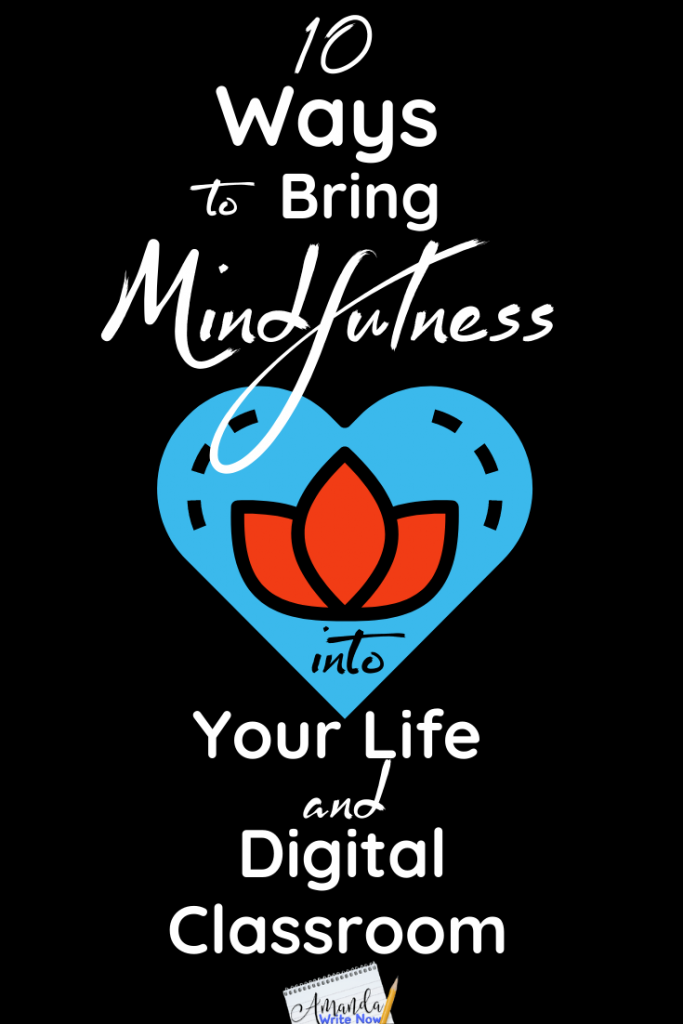
Do you often feel overwhelmed with all you have to do? Maybe you feel scattered and aren’t sure what to focus your energy on. Mindfulness in your personal and professional life can most definitely help alleviate these anxieties. In this blog post I’ll share ten ways you can begin to bring more mindfulness into both your personal and professional life. You’ll learn what mindfulness is and how you can begin practicing in your personal life so you can start bringing these practices into your classroom.
1. Teach Students About Mindfulness
Before you can begin bringing these practices into the classroom you need to have a thorough understanding of mindfulness and personally make efforts to incorporate meditation and mindfulness into your personal life. In the video below I define mindfulness as paying attention to the present moment as often as possible with your five senses. I also describe activities you can do throughout the day to incorporate mindfulness into your life.
https://www.youtube.com/watch?v=quPwti6MlPI&feature=youtu.be
I recommend explicitly teaching students the definition of mindfulness. You might even consider showing them the video above. My favorite website for all things mindfulness is mindful.org. You can find many articles to read with students, videos to show and guided meditations on this website.
2. Teach Students About Meditation
- Get comfortable, this is super important! You can still on a chair or lay down. I enjoy laying down, but in class I will model sitting comfortably in a chair.
- Take a few deep breaths in and out, paying attention to the sound of your breath and the feeling of it in your body. Your belly or chest may expand on the exhale. Notice these sensations.
- After a few calming deep breaths, breathe normally and if you are comfortable close your eyes.
- Your job now is just to notice when thoughts arise. When they come up (and they will), you just need to note the thought. I like to visualize popping a bubble. Then, bring your mind back to your breath. It might help to count each breath.
- Be kind to yourself. The goal is not to stop thoughts. They will never stop. The goal is to notice your thoughts and practice bringing your attention back to the body and breath.
3. Be a Model of Slowing Down
How many pauses do you take throughout your day? How many times do you stop and take a few deep breaths? How many times do you scan your body and focus attention on how you are feeling? If the answer is none, you can change this. You can also let your students know that you are making an effort to slow down and breathe during class and they can join in on making this a goal for themselves too. Believe me, it feels incredibly good to slow down, especially in a fast paced classroom environment.
4. Teach Brain Science
There are many studies proving that meditation literally changes the brain! This is quite incredible and the science might convince you and your students why these practices are important.
Check out the different parts of the brain that are impacted by meditation in this informative yet straightforward article: How Meditation Changes the Brain. It also includes footnotes that cite the studies this information came from. You could teach about citations, meditation and the brain all at once!
There are also many articles online about the benefits of mindfulness. When introducing students to mindfulness, you might also read and discuss an article like this one from The Harvard Gazette together: Harvard researchers study how mindfulness changes the brain in depressed patients.
5. Share, Read and Discuss Resources
There are so many tools available to live a more mindful life. Here are some of my favorite:
- Mindful.org– tons of articles to read with students and audio meditations available here.
- HeadSpace– this was the app that taught me how to mediate. It’s great for kids and adults.
- The Calm App-this is a very popular app with lots of different voices, music, videos and even courses.
- Insight Timer-this is my new favorite app for meditation and learning. There are so many wonderful options with this app including guided meditations, yoga, courses, videos and more!
- Mindfulness for Teens YouTube Playlist- I created this playlist with eleven engaging videos to teach about mindfulness and meditation. All the videos have been vetted and are appropriate for adolescents.
http://www.youtube.com/embed/w6T02g5hnT4
Yoga with Adriene– I am a huge fan of Adriene’s work and am even a part of her membership community. She is such a kind, gentle yoga instructor and is a great role model for young people, she’s very young herself and so inspiring.
6. Discuss The Process of Habit Formation
Teaching about habit formation can be a powerful wake up call for you and your students! Here are some key ideas you should know about habit formation:
- There are two types of habit formation methods-quitting an already formed habit or starting a new one.
- Our brains are designed to protect us and like the path of least resistance, think easy, whenever trying to quit a habit or start a new one, we need to make it as easy on ourselves as possible so the brain doesn’t get too upset and rebel.
- Quitting a habit can be done by replacing the old habit with a new habit that we enjoy and are excited about.
- Starting a new habit can be done with a process called, “habit stacking”. This involves thinking about an already firmly established habit such as eating breakfast in the morning and “stacking” the new habit on top of that already established one. This idea is detailed in one of my favorite books about habit formation, Atomic Habits by James Clear. *This link is an Amazon Affiliate link. This means if you purchase the book through my link, I will receive a commission. You will not be charged extra. I only recommend books I truly love and have changed me in some way.
https://youtu.be/-moW9jvvMr4
7. Discuss and Read About Media Addiction
Meditation and mindfulness have been proven to support addiction and obsessive behavior tendencies.
It makes complete sense that this would be the case. When you meditate you detach yourself from thoughts, you become an observer of those thoughts. You notice them and bring your attention back to your breath or body. You don’t get consumed by them as easily. So, how do you relay this information to your students? I’d start by reading and discussing articles like the ones below:
- Can Mindfulness Stop Internet Addiction in Teens? By The Greater Good Science Center of Berkeley
- Meditation can help with addiction on HeadSpace
- 4 Ways to Hack Your Screen Addiction on Mindful
After reading some informative articles with students, you’ll definitely want to facilitate a meaningful discussion with them about this topic. What has worked for them? What is hard about this day and age? How do they feel after hours and hours of screens?
Be open to all student responses. Some students might don’t feel it’s a problem, and we need to accept that’s where they are right now. At some point in the future maybe these resources and discussion will have an impact, it just might not be today. Acceptance of all the flaws that come with human nature and dropping expectations about what people should and shouldn’t do is a huge part of living a more mindful life. It’s also one of the most challenging parts!

8. Show Students These TED Talks
The Ted Talks below are short and worth watching and then showing to your students! You could use them to start a discussion about mindfulness or meditation, model public speaking skills, teach note-taking skills or to put on a playlist for students to watch asynchronously.
- All it takes is 10 mindful minutes-This is a very short talk by Andy Puddicombe, the creator of the app HeadSpace. Puddicombe also has a book called The HeadSpace Guide to Meditation and Mindfulness that is excellent and could even be recommended to students.
- You aren’t at the mercy of your emotions–your brain creates them-This fairly short talk is about how emotions are just our brain’s guess based on past experiences. It’s a talk by Lisa Feldman Barrett, the author of an excellent book called How Emotions are Made. This book isn’t really appropriate for middle school students but some advanced high schoolers might like it.
- Debunking the 5 Most Common Meditation Myths-This excellent and informative 17 minute TEDx Talk is definitely worth watching if you are meditation resistant. Light Watkins explains that many of the reasons you are resistant to meditation aren’t good enough reasons not to meditate! There are a few parts you might want to skip with your students, so make sure to watch this one before showing it to students.
9. Teach About Different Types of Meditation
There are many misconceptions about meditation such as that you have to sit cross legged on the floor with your pointer finger and thumb touching and pointing up on your knees. Many of my students have jokingly put themselves into this position when I try to facilitate a mediation practice in my classroom. Instead of getting frustrated with these students, this can be the perfect opportunity to teach about different types of meditation. The video below is kid-friendly and discusses five types of meditation: traditional, walking, guided, auditory and visual.
http://www.youtube.com/embed/mjMLQjhEKzk
This video doesn’t even scratch the surface when it comes to the variety of meditation practices out there. I’ve recently gotten really into chanting meditation and love the Kritan Kriya Meditation of Sa, Ta, Na, Ma. This meditation helps tremendously when my mind is caught up in stressful thoughts or craving. HeadSpace also has this blog post about 16 Types of Meditation.
10. Facilitate 3 Minute Class Meditations
Meditating in a classroom setting can be overwhelming and to be frank…awkward! Keeping 30+students silently focused on their own breath is no easy task. This is why I recommend starting with just a few minutes at first. You can do this:
At the beginning of each class or Google Meet/Zoom guide students to find a quiet space in their home (if possible) or put on headphones so all they hear is your voice. Mute all students except yourself.
Start a timer and explain to students that for the next 3 minutes all you want them to do is pay attention to their breathing.
Tell them to sit up straight and take a deep breath in through their nose, hold it at the top, and release through their mouth. Guide them to do this deep breathing about five times.
Next, have students breathe normally, close their eyes if they are comfortable. If they are not comfortable closing their eyes, they can lay their head down or just look at a point in front of them on their computers, their desk or the floor. Explain that their only job in the next few minutes is to breathe normally and count their breaths up to ten. The in breath is one, the out breath is two and so on. Explain that when their mind wanders (it most definitely will), notice and come back to counting the breath.
That’s it! It’s pretty simple but powerful and there is science and research to back up how powerful daily meditation practice is!
Once your students have been doing the 3 minute meditation for a month or so, you might feel they are ready for the next step, 5 minutes, then 10!
Next Steps…
I believe being a teacher is about more than teaching our content area. In my opinion helping students cope with our fast paced world is a duty all teachers need to take on. Now, after reading this blog post, you are armed with the information and tools to help you do just that. If you want more done-for-you-lessons, videos and activities for students to teach them not just mindfulness but journaling and sketchnoting too, check out the resource below.
The Distance Learning Engagement Pack!


Thank you very much for this beautiful article. I really enjoyed reading this. I appreciate your thoughts and ideas. Well done.
Thank you for taking the time to leave this thoughtful comment Reese. It means the world to me! I’m so happy to help.